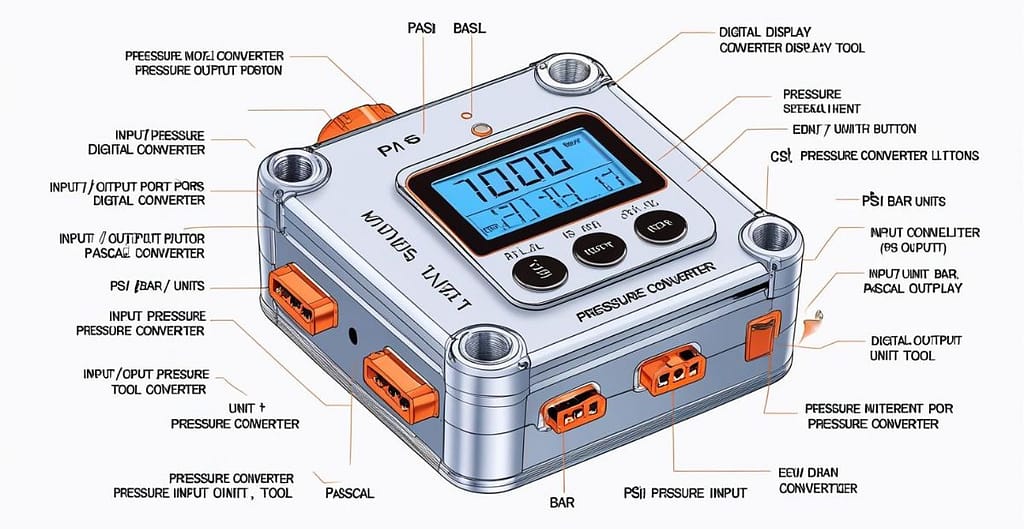Pressure Unit Converter
Easily convert between different pressure units including Pascals, PSI, Bar, Atmospheres, mmHg and more with our accurate and user-friendly tool
Pressure Conversion Tool
Convert between various pressure units instantly
Understanding Pressure Measurement
What is Pressure?
Pressure is defined as the force applied perpendicular to the surface of an object per unit area. The SI unit for pressure is the Pascal (Pa), which equals one Newton per square meter. Pressure measurement is crucial in various fields including physics, engineering, meteorology, and medicine.
Common Pressure Units and Their Applications
Pascal (Pa)
The Pascal is the SI derived unit of pressure, named after the French physicist Blaise Pascal. It’s defined as one newton per square meter. While it’s the standard unit, it’s relatively small for many applications, so kilopascals (kPa) and megapascals (MPa) are often used.
Atmosphere (atm)
Standard atmosphere is a unit of pressure defined as 101,325 Pa. It’s approximately equal to the atmospheric pressure at sea level on Earth. This unit is commonly used in chemistry and physics.
Bar
The bar is a metric unit of pressure, but not part of the International System of Units (SI). It is defined as exactly 100,000 Pa. It is approximately equal to the atmospheric pressure on Earth at sea level. The bar is commonly used in meteorology and industrial applications.
Pounds per Square Inch (PSI)
PSI is a unit of pressure commonly used in the United States and United Kingdom to measure pressure in various applications including tire pressure, water pressure, and many others. It is defined as the pressure resulting from a force of one pound-force applied to an area of one square inch.
Millimeters of Mercury (mmHg)
Millimeter of mercury is a manometric unit of pressure, formerly defined as the extra pressure generated by a column of mercury one millimeter high. It is currently defined as exactly 133.322387415 pascals. It is used in medicine for blood pressure measurements and in meteorology for atmospheric pressure.
Pressure Conversion Formulas
Converting between pressure units requires specific conversion factors. Here are some of the most common conversion relationships:
- 1 atm = 101,325 Pa = 101.325 kPa = 1.01325 bar
- 1 bar = 100,000 Pa = 0.986923 atm = 14.5038 PSI
- 1 PSI = 6,894.76 Pa = 0.068046 atm = 0.0689476 bar
- 1 mmHg = 133.322 Pa = 0.00133322 bar = 0.0193368 PSI
Applications of Pressure Measurement
Pressure measurement is essential in numerous applications across various industries:
- Meteorology: Atmospheric pressure measurement for weather forecasting
- Medicine: Blood pressure monitoring
- Engineering: Pressure testing in mechanical systems
- Automotive: Tire pressure monitoring
- Aviation: Altitude measurement and cabin pressure control
- Industrial processes: Monitoring and control of pressurized systems
Historical Development of Pressure Measurement
The concept of pressure and its measurement has evolved significantly over centuries. Evangelista Torricelli invented the mercury barometer in 1643, which led to the first accurate measurements of atmospheric pressure. Blaise Pascal conducted important experiments demonstrating that atmospheric pressure decreases with height. These early discoveries laid the foundation for modern pressure measurement techniques.
Frequently Asked Questions About Pressure Conversion
Absolute pressure is measured relative to a perfect vacuum (zero pressure), while gauge pressure is measured relative to atmospheric pressure. Most pressure measurements in daily life (like tire pressure) are gauge pressure. Absolute pressure equals gauge pressure plus atmospheric pressure.
To convert PSI to bar, multiply the PSI value by 0.0689476. For example, 30 PSI equals 30 × 0.0689476 = 2.06843 bar. You can also use our pressure converter tool above for accurate and instant conversions.
Different pressure units developed historically in various fields and regions. Scientists developed Pascal, meteorologists used bar and mmHg, engineers in English-speaking countries preferred PSI, and atmospheric scientists used atm. This diversity persists due to tradition and the specific needs of different industries.
Standard atmospheric pressure at sea level is defined as 101,325 Pascals (Pa), which is equivalent to 101.325 kPa, 1.01325 bar, 14.6959 PSI, 760 mmHg, or 29.9213 inches of mercury (inHg).
Atmospheric pressure decreases with increasing altitude because there is less air above weighing down. The relationship is approximately exponential – pressure drops by about 50% at an altitude of 5,500 meters (18,000 feet) compared to sea level pressure.

Use our more free tools
Number to Roman Numerals
Currency Converter tool
Speed Converter
For more Free tools go to
QR code generator